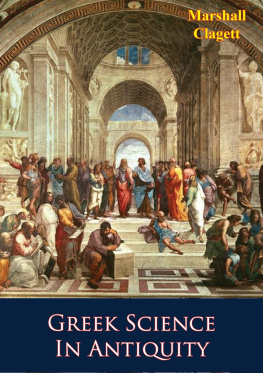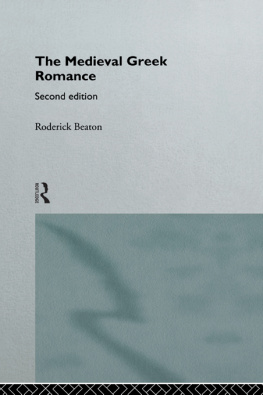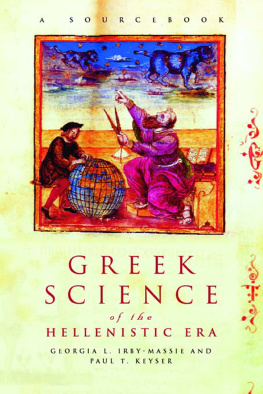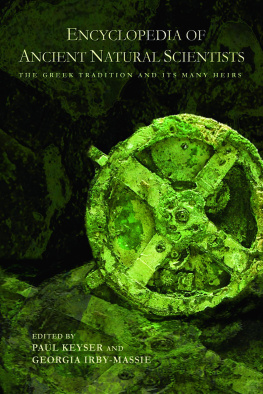

This edition is published by PICKLE PARTNERS PUBLISHINGwww.pp-publishing.com
To join our mailing list for new titles or for issues with our books picklepublishing@gmail.com
Or on Facebook
Text originally published in 1955 under the same title.
Pickle Partners Publishing 2016, all rights reserved. No part of this publication may be reproduced, stored in a retrieval system or transmitted by any means, electrical, mechanical or otherwise without the written permission of the copyright holder.
Publishers Note
Although in most cases we have retained the Authors original spelling and grammar to authentically reproduce the work of the Author and the original intent of such material, some additional notes and clarifications have been added for the modern readers benefit.
We have also made every effort to include all maps and illustrations of the original edition the limitations of formatting do not allow of including larger maps, we will upload as many of these maps as possible.
GREEK SCIENCE IN ANTIQUITY
BY
MARSHALL CLAGETT
TABLE OF CONTENTS
Contents
DEDICATION
To
LYNN THORNDIKE
PREFACE
I HAVE written this volume for the adult or student reader without specialized scientific background, but with a knowledge of secondary-school mathematics. The reader I have visualized, then, is the non-specialist who is beginning the study of history of science, although I hope the work will not be without interest for the specialist as well.
In this volume I have attempted to give especial and marked attention to the fate of Greek science in late antiquity. Elementary texts in the past have long ignored this aspect of Greek science. The importance of the course of Greek science in late antiquity is evident, for it was during this period that much of the Greek scientific corpus was put into the form in which it passed to the medieval Latin West. We are justified, then, in considering this volume as an introduction to medieval and early modern sciencethat science being considered as a transformation of Greek science. In fact, I am preparing a volume on medieval science that will take up the development of science where this volume leaves off.
One of my colleagues has raised a question as to whether the title Greek Science in Antiquity is a tautology. My answer is no for two important reasons. In the first place there is other than Greek Science in antiquity (e.g., Babylonian Science or Indian Science). Secondly and more important, I have stressed throughout the volume that the Greek scientific corpus has had a long life in antiquity, in the Middle Ages, and in early modern times. This volume covers only the first part of that long life.
I should like to give special thanks to Professor Thomas Smith, of the California Institute of Technology, who for several years assisted me in the adventure of trying to teach Greek science to non-specialized students, and who read with care the first draft of this book. Thanks are due also to Professor I. E. Drab kin, of the City College of New York, who read the manuscript in typescript and offered a number of valuable suggestions for its improvement, and to my colleague Professor R. C. Stauffer of the History of Science Department, who read proof and saved this volume from a number of errors.
M. C.
University of Wisconsin
ILLUSTRATIONS
1 The Celtic horse
2 Reconstruction of a polychrome bison
3 Two bison in relief
4 The Celtic horse and the reindeer
5 A sundial
6 The manner of setting stones into place in the building of pyramids
7 A diagram representing the use of the principle of the lever to set stones into place
8 The Babylonian method of measuring an irregular field
9 Babylonian world map
10 Charles Singers representation of Galens vascular systems
11 A Babylonian tablet
12 Bust of Theophrastus
13 A mosaic found in Herculaneum
14 A bust from Herculaneum, believed to be that of Archimedes
15 Bust of Aristotle
16 An axle-wheel train
17 The bent lever
18 Heros steam engine
19 The refraction of light
20 Apparent path of Mars in 1939
21 Stations and retrogradation of Mars explained on the basis of Copernican theory
22 A cross section of the four concentric spheres used by Eudoxus to explain planetary motion
23 The horse-fetter
24 Eratosthenes determination
25 The nature of eccentric and epicycle circles
26 The equivalence of the epicycle motion of the sun with an elliptical path
27 The Ptolemaic system of planetary movements
28 How the epicycle movement of a planet accounts for the stations and retrogradations of the planet
29 The precession of the equinoxes
30 A dioptra, or sighting instrument
31 A bust from Herculaneum
32 Greek alchemical equipment
33 Ursa Major
34 An early medieval graphing of planetary movements
35 An early medieval graph
36 An early Lunar-tide wheel
37 The quadrature of the circle
38 A parabolic segment
39 Intersecting parabolas
40 The parabola
41 The ellipse
42 The hyperbola
43 Commensurable magnitudes on a lever
44 Incommensurable magnitudes on a lever
45 Equivalence of epicycle and eccentric motions
46 The movement of Venus
47 The movement of Mercury
48 The movement of the Moon
49 Chords and sines
50 The squares of complementary chords
51 The difference of chords
52 The chord of half the angle
PART ITHE ORIGINS OF SCIENCE IN ANTIQUITY
CHAPTER ONEScience in Egypt and Mesopotamia
I
TODAY most of us are keenly aware of the close ties that exist between science and the character of our civilization. The historian of science hopes to throw light on this relationship by investigating how and why science grew out of the more general province of learning to occupy its dominant position. In this investigation he must study the unfolding life of science. He must, in addition, evaluate the details uncovered and judge their significance for modern scientific attitudes, principles, and methods.
As in the history of any other aspect of mans activitypolitics, economics, religion, etc.so in the history of his science, a study of the early stages of growth is of great importance for an understanding of the modern institution. This volume attempts to treat the phases of science that lie in antiquityfrom the very early empirical efforts of prehistoric man through the relatively mature scientific activities in Greek antiquity. Our volume will, then, cover an enormous period of time, of which the beginning is unrecorded and the terminal date is about A.D. 600.
It is generally agreed that the learning of antiquity was digested in the Middle Ages and Renaissance to form the chief nourishment for growth of early modern thought. Thus early modern science grew out of Greek science and philosophy as modified by the natural philosophers of Islam and the Latin West. The acceptance of this essential continuity in the development of Western thought does not obviate the novelty of the scientific activity of the seventeenth century, the century of Galileo, Boyle, Hooke, Leibniz, and Newton. It serves rather to clarify that novelty, to show how it arose in great part from the interplay, modification, and rearrangement of older stock ideas as they were fashioned into an essentially new system.
Next page









